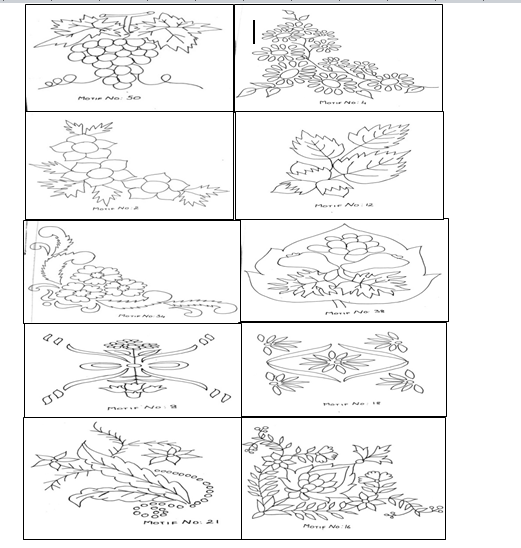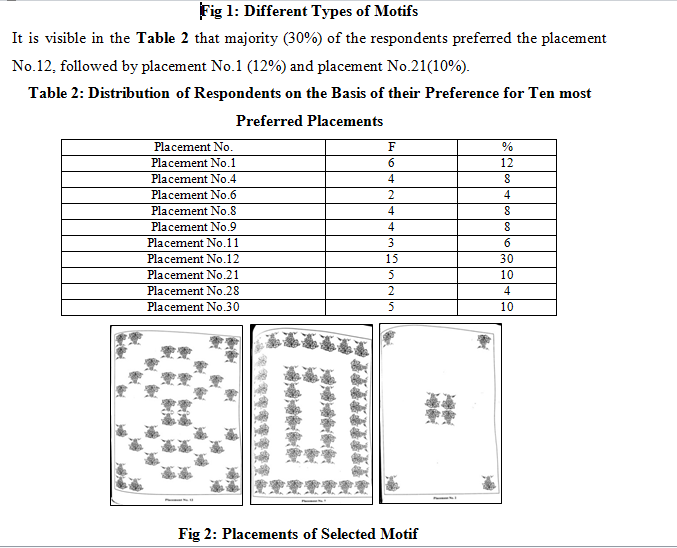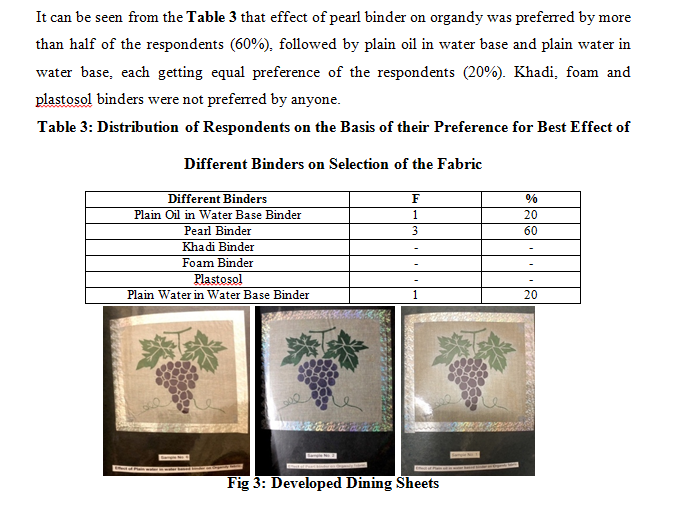Alleviation: An International Journal of Nutrition, Gender & Social Development, ISSN 2348-9340
Volume 4, Number 4 (2017), 1-9
© Arya PG College, Panipat & Business Press India Publication, Delhi
www.aryapgcollege.com
Effect of Different Binders Through Screen Printing on Dinning Sheets Using Selected Motif
Sandeep Reen
Assistant Professor, Department of Home Science
Guru Nanak Girls College, Yamunanagar , Haryana, India
Email: sandeepreen18@gmail.com
Introduction
Man’s yearning for beauty to introduce grace and elegance into the monotony and drabness of everyday’s life led gradually to decorative designs through fine form and colour. His urge for decoration of immediate surroundings has remained constant and has enchanted him through ages. It is like a magic wand that transforms nothing into something, fills blankness with the substance and emptiness with meaningfulness.
The primitive man decorated with colour and design first his personal, articles of everyday use, later weapons and finally his surroundings (Dongerkerry 1968 &Chattopadhyay 1975).
Enrichment of textile ornament by the process of dyeing and printing has a dominating influence upon mankind from pre-historic days and has remained so throughout the ages.
Indian textiles have been coveted all over the world since the days of ancient civilization. Many popular types of designs are derived from historical textile style (Mittal 1998).
To meet this ever increasing demand of the people for variety, it is important to find improved and effective ways of printing with screens. Not only, the prints should be obtained easily and in less time but they should also be appealing and attractive to the eye.
Screen printing is one of the graphic art today and has grown into a industry employing thousands of people, all over the world. Quality screen printing which may be done mechanically, semi-automatically and manually is producing such items as high quality drapery materials, decorated silks, wool, linen and synthetic fiber goods, terry cloth materials, table clothes, blouses, skirts, bag, ties, athletic wearing apparel, and napkins etc.
The results of the present study will serve as a source of knowledge about screen printing and different binders. It may give considerable scope to the needs and imagination of printers. Screen printing undoubtedly might attract the females to print their own costumes, home furnishings, wall panels and other articles which are used in our daily life.
The findings of this study will be useful to the home based boutique owners to produce dresses with a variety of prints according to the preference of consumer. The present study was undertaken to find out the preferences of respondents for motifs, for placements of motifs and for best effect of different binders on selection of the fabric. The delimitation of the present study was that only white coloured fabric was used in making dining sheets.
Methodology
Two groups of respondents were selected with random sampling. First group comprised of fifty home science students of Bachelor of Science Final Year and Master of Science of Department of Clothing and Textile, Guru Nanak Girls College, Santpura, Yamunanagar. The second group was of lecturers from the Clothing and Textiles Department of same college.
Survey and experimental methods were used to carry out the study. An interview schedule was carefully prepared to collect the details regarding respondents’ preference of different types of material, kind of motif, color schemes, color and different types of binders and their effect on different fabrics and placements to be used in screen printing of dinning sheets.
Different types of binders were brought from the market to see the different effects on the different fabrics. For preparation of the color paste, pigment dye was added in the binders and few drops of acrofix were also added to make the color fix on the fabric. As the two colors had to be applied on the dining sheets, two screens were prepared, half of the design on the one screen and other half of the design on the another screen. Then the screens were placed according to the placement and color was applied with the help of squeeze from the one end to the another. After every print, the screen was cleaned by the rough cloth to avoid the blocking of the screen. In this way, all the sheets were made. Thus printing was done using the two selected colors simultaneously by keeping the two screens to complete the motif.
The printing process was followed in completion of the six dining sheets according to the selected placements and different binders on selected fabrics.
Results and Discussion
It can be seen from the Table 1 that majority of (30%) respondents gave preference to motif number 50, which was further used for the screen printing of dining sheets.




Conclusion
On the basis of results obtained from the present study, it can be concluded that out of the six binders used on four different fabrics, pearl binder gave the best effect on organdy fabric, as it was preferred by the majority of the respondents
References
Chattopadhyay K (1968) Handicrafts of India. New Delhi: Indian Council for Central Relations.
Dongerkerry KS (1969) The India Saris. New Delhi: The All India Handicrafts Board Co.
Mittal S (1998) Designing and Developing Printed Sarees by Most Preferred Hand Printing Techniques. Unpublished Master’s Dissertation, Kurukshetra University, Kurukshetra.
Storey J (1947) The Thames and Hudson Mannual of Textile Printing. London : Thames and Hudson Ltd.

